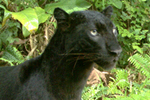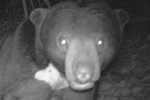
Perturbed male elephant in Tanzania. Photo by: Rhett A. Butler.
One of the biggest challenges for big African wildlife like lions, elephants, and buffalo is movement across native habitat that is increasingly being encroached on by humans. Animals find their movement restricted by roads, fences, and property boundaries which fragment the landscape. Without safe, smart, and well-maintained corridors between designated wildlife areas, animals can get cut off from resources needed for survival and from potential mates (putting genetic health at risk), even while conflicts with humans become more frequent.
A new study in mongabay.com’s open access journal Tropical Conversation Science reviews the importance of functional wildlife corridors, examines the causes of consequences of two failing corridors in Tanzania, and recommends actions needed to secure endangered safe passages for animals.
“Conserving wildlife corridors is increasingly important for maintaining ecological and genetic connectivity in times of unprecedented habitat fragmentation,” the researchers write.
In order to keep big animal populations healthy, movement across habitat must be as fluid as possible. In their study, the researchers aimed to document the state of wildlife corridors in Tanzania, but they insist this is also a global problem. They report that as of 2009 there were 31 documented wildlife corridors across mainland Tanzania, of which 24 (77 percent) were placed in categories of “extreme” or “critical” condition, meaning they are predicted to cease being functional within five years without intervention.
“Corridors are being lost throughout the world at escalating speed,” according to the paper.
The researchers’ study area focused on the corridor between the Udzungwa Mountains and the Selous Game Reserve (SGR) in south-central Tanzania–a major link between western and southern wildlife communities, especially for the African elephant (Loxodonta africana), which historically crossed the valley to move between the Udzungwas and the SGR. This area, the Kilombero Valley, is one of Africa’s largest wetlands; it is also prized land for farming and in recent years has seen a rapid increase of human settlements. With more people in the area, an earlier corridor assessment in 2005 found that connectivity was barely persisting via the two remaining connective routes, the Nyanganje Corridor and the Ruipa Corridor.
From 2007-2010, researchers examined the health of these two corridors through a combination of methods consisting of questionnaires and interviews, dung and disturbance transects, aerial surveys and ground mapping. They found that both corridor routes have become degraded over the last five years due mainly to increased farming and livestock.
For example, researchers found that both corridors have less elephant and other animal traffic than they had in 2005. In the Nyanganje Corridor (now almost entirely classified as farmland), 80 percent of questionnaire respondents in 2006 reported elephants crossing their farms each year from January to March. But in 2010, 98 percent of respondents believed the corridor had closed. Large mammals were only recorded at the western and eastern ends of the corridor, within 1 kilometer of the boundaries of the Nyanganje Forest Reserve and Selous Game Reserve, respectively. Elephants were reported as regularly leaving the forest at either end of the corridor, but turning back after encountering farms. In the Ruipa Corridor, results showed that between 2007 and 2010 relative abundance of signs declined significantly for all detectable wild mammal species while signs of cattle were detected in 100 percent of sections in 2010, compared with 37 percent in 2007. In 2007, 78 percent of respondents reported having elephants on their farms and 59 percent had buffalo, compared with 38 percent and 10 percent respectively in 2010. Villagers were of the opinion that elephants movements no longer occurred every year.
But there is hope for the corridors year, according to the authors. Encouraged by the still-low numbers of humans actually occupying the area, the researchers suggest compensation and relocation offers for local farmers willing to move. The authors also express hope in animal resilience as elephants may remember old migration routes many years after being denied access to them, therefore blocked corridors should not be considered irreversible. Also, despite the recent blocking of Nyanganje and Ruipa corridors, several residents reported that on both routes elephants are still observed each year attempting to cross from either end.
“Continued attempts by elephants to cross by both routes suggest that connectivity can be restored,” the researchers write.
Finally, the authors insist that corridors must be well enforced and maintained to be effective in the conservation of endangered species. They recommend locally supported, regional approaches which include small stakeholders, government, and the private sector in planning and managing such corridors.
“Corridor restoration will require a combination of site-tuned land-use planning and protection harmonized among various private and public land owners, with resident communities being fully involved,” the authors write. “Through the flexible and coordinated approach outlined here, the Nyanganje, Ruipa and Mwanihana-Magombera corridors could be re-opened, thus restoring a critical ecological link for Tanzania.”
CITATION: Jones, T., Bamford, A. J., Ferrol-Schulte, D., Hieronimo, P., McWilliam, N., and Rovero, F. 2012. Vanishing wildlife corridors and options for restoration: a case study from Tanzania. Tropical Conservation Science Vol. 5(4):463-474.
Related articles
Development halted in crucial wildlife corridor in Malaysia

(11/07/2012) Kenyir Wildlife Corridor in northeast Malaysia is teeming with wildlife: elephants, gibbons, tigers, tapirs, and even black panthers (melanistic leopards) have been recorded in the 60 kilometer (37 mile) stretch of forest. In fact, researchers have recorded over 40 mammal species (see species list below), including 15 threatened with extinction according to the IUCN Red List. When these findings were presented by scientists to the Terengganu state government action followed quickly: all development projects have been halted pending a government study.
Jaguar conservation gets a boost in North and Central America

(09/27/2012) Jaguar conservation has received a huge boost in the past few months both in Latin America and in the U.S. An historic agreement singed between the world’s leading wild cat conservation organization Panthera and the government of Costa Rica in addition to a new U.S. Fish and Wildlife Service (FWS) proposal bring renewed hope to the efforts to revive the iconic jaguar in its current habitat and return the cats to the American Southwest.
Buffer zones key to survival of maned wolf

(09/17/2012) Known for its abnormally long lanky legs, its reddish-orange coat, and its omnivorous diet, the maned wolf (Chrysocyon brachyurus) is one of the more beautiful and bizarre predators of South America. However its stronghold, the Brazilian Cerrado, is vanishing rapidly to industrialized agriculture and urban development. Now, a new study in mongabay.com’s open access journal Tropical Conservation Science reveals the key role of buffer zones and unprotected areas in keeping the maned wolf from extinction in the Cerrado savannah, where only 2 percent of the ecosystem is under protection.
Photos: camera traps capture wildlife bonanza in Borneo forest corridor

(09/10/2012) Camera traps placed in a corridor connecting two forest fragments have revealed (in stunning visuals) the importance of such linkages for Borneo’s imperiled mammals and birds. Over 18 months, researchers with the Sabah Wildlife Department (SWD) and the Danau Girang Field Centre (DGFC) have photographed wildlife utilizing the corridor located in the Lower Kinabatangan Wildlife Sanctuary in Malaysian Borneo.